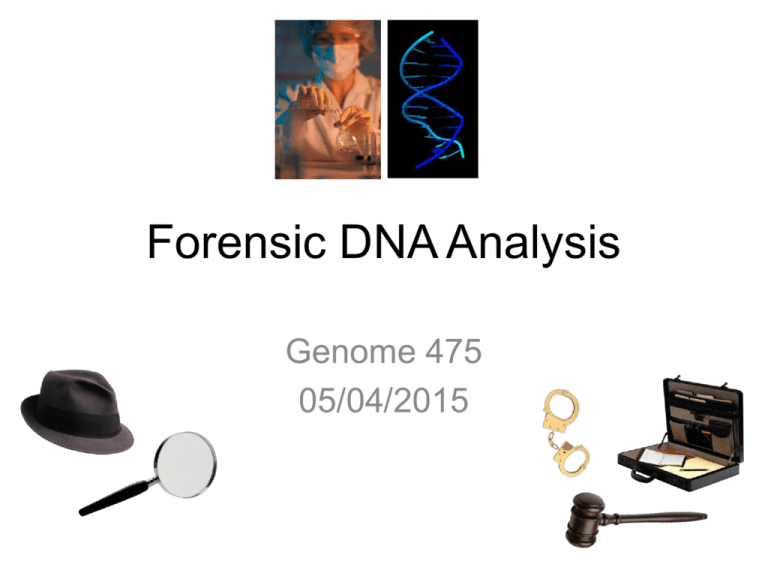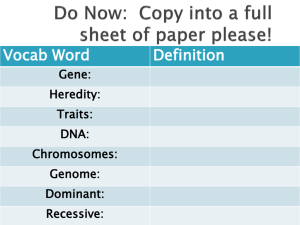First crime solved using DNA forensics
advertisement

Forensic DNA Analysis Genome 475 05/04/2015 Forensics “Of, relating to, or denoting the application of scientific methods and techniques to the investigation of crime” http://www.oxforddictionaries.com/ First biological testing in crime Part of forensic serology 1900: Karl Landsteiner described the ABO blood groups RBC phenotype Reaction with Anti-A Reaction with Anti-B O - - A + - B - + AB + + Landsteiner et al. 1900 Forensic Processing Workflow Collection of evidence Screenin g for blood, semen, saliva, etc. DNA extraction Quantitation of DNA Amplification of DNA Analysis of DNA Generation of Result DNA Collection From crime scene items Blood, seminal fluid, saliva, epithelial cells, and faeces Cigarette butts, drinking vessels, bite marks, masks, door handles, steering wheels, knife handles, hair follicles Reference sample: blood, buccal swabs, pulled hairs An Introduction to Forensic Genetics 2011 Discovery of minisatellites Alec Jeffreys (1985) Studying seal myoglobin and discovered the first minisatellite Human myoglobin gene Jeffreys et al. 1985 http://www.wildlife-photography.uk.com/blog/?p=7033 Minisatellites Prone to be in subtelomeric regions of chromosomes Have core repeat sequence (6 to 100 bp) Alleles range from 1 kb to 20 kb Result in multiple alleles Restriction Fragment Length Polymorphism (RFLP) DNA CS DNA fingerprinting GGGCAGGAXG S1 S2 Detection of low amounts of DNA Invention of PCR by Kary Mullis (1983) Amplification of small quantities of DNA Focus on microsatellites (short tandem repeats) Short tandem repeats (STRs) Throughout the genome Core unit between 1 and 6 bp Alleles from 50 to 300 bp Those used in forensic genetics are tetranucleotide repeats (4) An Introduction to Forensic Genetics 2011 STR analysis PCR Dye signal Capillary Electrophoresis 36 56 Size (nt) Short tandem repeat output Output for each STR is the repeat count Easy for storage in databases STR Repeats 1 10,12 2 8,13 3 7,9 4 8,8 5 13,14 6 12,15 7 7,6 Short tandem repeats (STRs) Selection criteria for forensics Discrete and distinguishable alleles Amplification High of locus is robust power of discrimination Absence of genetic linkage with other loci being analyzed Low levels of artifact during amplification Ability to be amplified as part of multiplex PCR Potential Problems Outcomes of DNA Result Exclusion (Non-match): Genotype profiles of suspect and crime scene are different Inconclusive: Genotype profiles can not rule out suspect. Match (inclusion): Genotype profiles of suspect and crime scene are exactly the same. Statistical significance is assigned to this by a match probability. (http://strbase.org/) Forensic DNA Typing, 2005 Summary of Techniques Test type Comments RFLP PCR Next generation sequencing Requires larger amounts of DNA (micrograms). DNA must be undegraded. Requires smaller amounts of DNA than RFLP Can be somewhat degraded Extremely sensitive to contamination at crime scene and in crime lab More prone to error than RFLP Most often used now due to speed and sensitivity New era arriving in forensic DNA analysis COmbined DNA Index System (CODIS) Examines 13 STRs The National DNA Index (NDIS) contains: >11,685,829 1,944,423 619,280 CODIS offender profiles, arrestee profiles forensic profiles has produced over 280,451 hits assisting in more than 267,461 investigations. Profile Applications Missing persons investigations Anastasia Romanov – daughter of Tsar Nicholas All of family except her and her brother were found in a grave Thought to be missing Ultimately her and her brother’s remains were discovered in another grave biography.com Profile Applications Mass disasters 9/11 As of March 2015: Of 2,753 people reported missing in the attack, remains of 1,113 have never been found www.nationalgeographic.com Profile Applications Paternity Eddie Murphy and Mel B First crime solved using DNA forensics Aronson et al. 2005 First crime solved using DNA forensics 1983: Rape and murder of a 15-year old girl (Lydia Mann) in Leicestershire 1986: Nearly identical case in nearby town (Dawn Ashworth) Police focused on a young kitchen porter with low IQ who ultimately confessed to the second crime DNA from crime scene did not match the kitchen porter DNA Aronson et al. 2005 First crime solved using DNA forensics ~5,000 men subjected to testing Blood groups DNA profiling Colin Pitchfork avoided the mandatory testing 1987: He was ultimately discovered and convicted of both crimes First crime to exonerate one person and incriminate another using DNA profiling Aronson et al. 2005 Current Efforts Innocence projecthttp://www.innocenceproject.org/ As of 4/27/2015 DNA exonerations: 329 Average number of years served: 14 Number of real perpetrators found: 140 Current Efforts www.innocenceproject.org/







